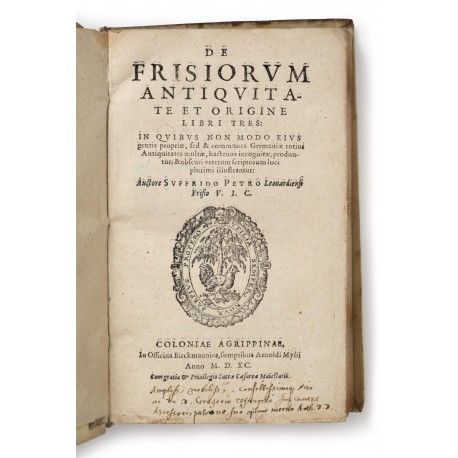De Frisiorum antiquitate et origine libri tres
- Subjects
- History, Dutch - Early works to 1800
- Authors/Creators
- Petrus, Suffridus, 1527-1597
- Printers/Publishers
- Mylius, Arnold, for the Heirs of Arnold I Birckmann, active 1585-1604
- Owners
- Fürstlich Fürstenbergische Hofbibliothek (Donaueschingen)
- Helfenstein-Gundelfingen, Froben von, active 1603
- Tengnagel, Gregor, c. 1555-c. 1593
- Tengnagel, Philipp, active 1580
- Other names
- Emmius, Ubbo, 1547-1625
- Fumerius, Bernardus, active 1598
Petrus, Suffridus
Ryntsmageest 1527 – 1597 Keulen
De Frisiorum antiquitate et origine libri tres.
Cologne, House of Birckmann, 1590
octavo (165 × 100 mm), (184) ff. signed †8 ††8 A–X8 and paginated (32) 1–335 (1). Printer’s device on title-page.
provenance Gregor Tengnagel (circa 1555–circa 1593), presentation inscription by the author on title-page Amplissimis nobilissimis consultissimoque viro ac dominis d. Gregorio Tegnagelio Juris camerae Assessori, patrono suo optime merito Auth. D.D. and another inscription on the upper cover Clariss. viro ac dno Gregorio Tegnagelio — Philipp Tengnagel — Graf Froben von Helfenstein, Kaiserlicher Kammergerichtspräsident zu Speyer (1593–1603), until 1627 — Fürstlich-Fürstenbergische Bibliothek at Donaueschingen — sale by Reiss & Sohn, ‘Auktion 68: Aus einer Süddeutschen Fürstenbibliothek, Teil 1’, Königstein im Taunus, 20 October 1999, lot 164
Vellum protecting headcap torn away, otherwise in excellent state of preservation.
binding contemporary flexible vellum; page-edges decorated with red stripes.
First edition of this history of the Northern Netherlands, relying on traditional accounts of the origin and identity of the Frisians to prove the ancient autonomy of the region, and thereby its independence from the dominant province of Holland.
The author (Sjoerd Pietersz), professor of philology at the universities of Erfurt and Cologne, and sometime secretary and librarian to Antoine Perrenot de Granvelle, established a line of legendary Frisian monarchs, beginning with Friso, his brothers Saxo and Bruno, who reputedly left India in the fourth century bc, studied with Plato, fought for Philip and Alexander of Macedon, and then settled in Frisia, where they drove away aboriginal giants and founded Groningen.1 The Frisian language, he claimed, inherited much from Greek and from Hebrew, and even more from Indian.2
Reprinted in 1598, the book instigated a controversy in which Ubbo Emmius and Bernardus Fumerius participated, watched closely by Scaliger.3
On the title-page and again on the upper cover of our copy, Suffridus Petrus has written presentation inscriptions to Gregor Tengnagel, a lawyer born at Louvain about 1555, who was then employed as a judge of the imperial court (Reichskammergerichtsassessor) in Speyer.4 Gregor’s books were inherited by his brother Philipp5 and afterwards passed through the Helfenstein library into the Fürstenberg library at Donaueschingen.6
references British Museum, Short-title catalogue of German books (London 1962), p.688; Herbert M. Adams, Catalogue of books printed on the continent of Europe, 1501–1600, in Cambridge libraries (Cambridge 1967), P–856; Verzeichnis der im deutschen Sprachbereich erschienenen Drucke des xvi. Jahrhunderts (Stuttgart 1991), P–1779
Clariss. Viro. ac d[omi] no Gregorio Tegnagelio
1. For context, see the articles in a special number of It Beaken: tydskrift fan de Fryske Akademy (volume 56, nos.2/3, 1994): Paul Noomen, ‘Suffridus Petrus en de Friese identiteit’, pp.146–187; Wiebe Bergsma, ‘Suffridus Petrus als landshistorieschrijver’, pp.80–123; Martin H.H. Engels, ‘Werken van Suffridus Petrus in de Provinciale Bibliotheek van Friesland’, pp.239–251.
2. Kees Dekker, The Origins of Old Germanic Studies in the Low Countries (Leiden 1999), p.27.
3. Anthony Grafton, Forgers and critics: creativity and duplicity in Western scholarship (London 1990), pp.121–123; Anthony Grafton, Joseph Scaliger: a study in the history of classical scholarship (Oxford 1983–1993), ii, pp.607–609.
4. Günther Groh, Das Personal des Reichskammergerichts in Speyer (Ludwighafen 1971), p.37; Biographie nationale … de Belgique, xxiv (Brussels 1926–1929), cols. 656–657.
5. Two books belonging to Phillipp Tengnagel, both in bindings fashioned from a fourteenth-century English manuscript, are described by Richard Linenthal, ‘“Whole shyppes full” of manuscripts: a sixteenth-century vellum wrapper’ in The medieval book and a modern collector: essays in honour of Toshiyuki Takamiya, edited by Takami Matsuda, Richard A. Linenthal and John Scahill (Suffolk, uk 2004), pp.419–426.
6. Josef Nolte, ‘Herkunft und Rolle der älteren Iuridica in der Donaueschinger Hofbibliothek’ in Mittel und Wege früher Verfassungspolitik. Spätmittelalter und frühe Neu zeit, Band 9 (Stuttgart 1979), pp.456–472 (pp.466–468 on the Tengnagel brothers, ‘Humanisten-Juristen älteren Typs’, and their libraries).





![Detail of author's presentation inscription on upper cover: Clariss. Viro. ac d[omi]no Gregorio Tegnagelio](https://www.robinhalwas.com/2406-small_default/016036-de-frisiorum-antiquitate-et-origine-libris-tres.jpg)


